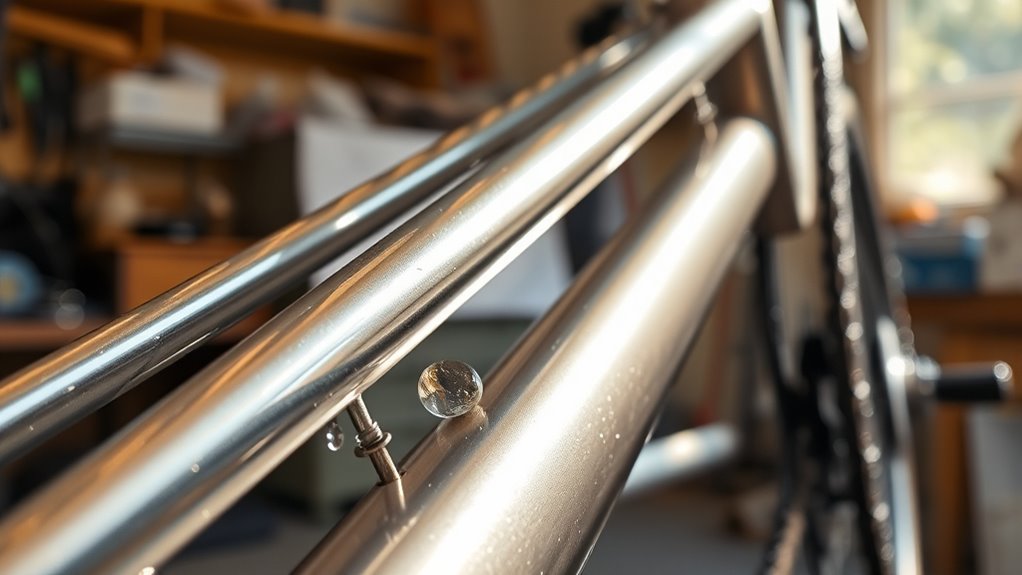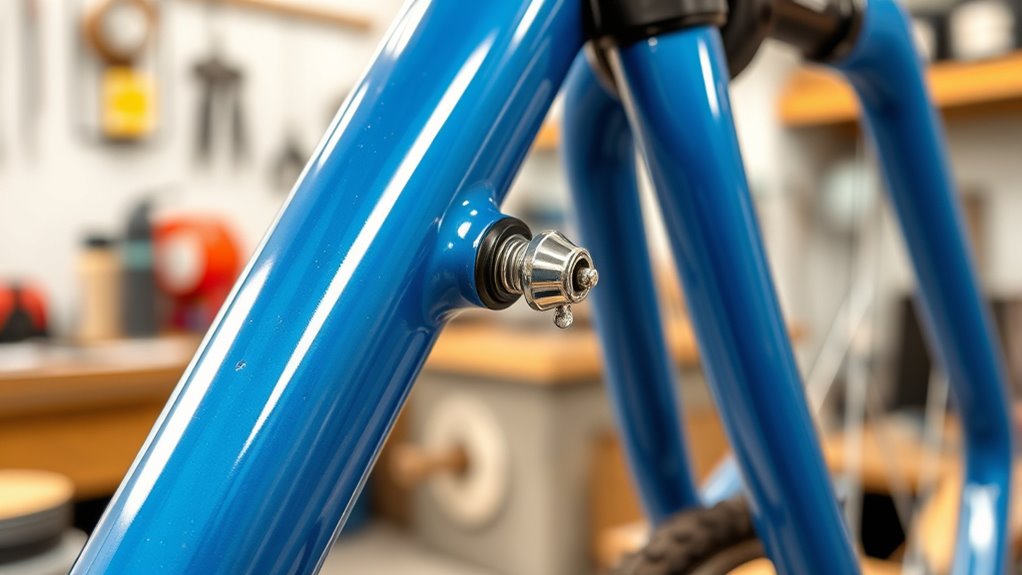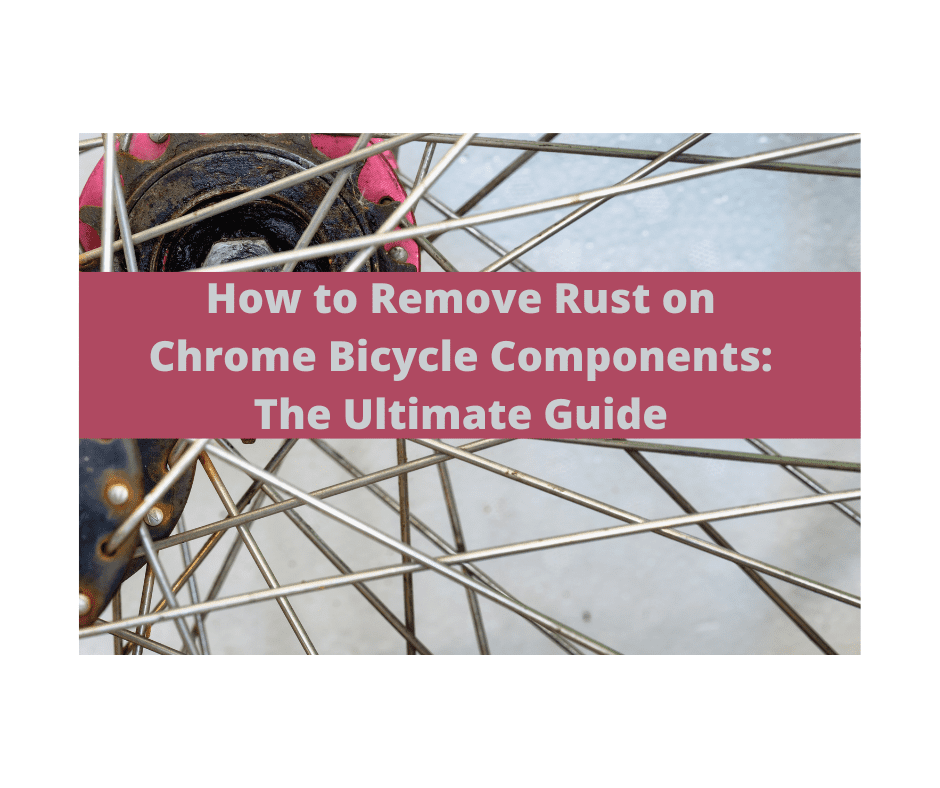To prevent rust on your bike, keep it clean and dry, especially after exposure to rain or mud. Regularly apply protective coatings like wax, grease, or silicone spray to create a moisture barrier. Store your bike in a sheltered area or use breathable covers to limit contact with humidity. Removing existing rust and lubricating moving parts also helps maintain its condition. For more detailed techniques, explore trusted tips to guarantee your bike stays rust-free longer.
Key Takeaways
- Regularly clean and dry your bike after exposure to rain or mud to prevent moisture buildup.
- Apply protective coatings like wax, silicone spray, or anti-rust sprays periodically for a moisture barrier.
- Store your bike in a dry, sheltered environment such as a garage or under a breathable cover.
- Lubricate chains, bolts, and moving parts biweekly with rust-inhibiting lubricants.
- Remove existing rust with rust removers or brushes, then reapply protective coatings to prevent future corrosion.
Understanding Rust and Its Impact on Bicycles

Rust forms when iron reacts with oxygen and water, creating a flaky, reddish-orange corrosion on bike parts. This process is called oxidation, where moisture accelerates the formation of rust on metal parts. When water or humidity contact ferrous metal components, they undergo chemical changes that produce rust, weakening the metal’s strength and durability. Rust isn’t just a surface issue; it compromises the structural integrity and safety of your bike over time. Metal parts made of iron or steel are especially vulnerable, unlike aluminum or titanium, which resist corrosion better. Exposure to rain, salty air, or damp environments increases rust’s speed and severity. Understanding this process helps you see why regular maintenance and protective measures are essential to keep your bike in top condition, and proper coating techniques can significantly slow down corrosion. Additionally, adopting corrosion-resistant materials can further enhance your bike’s longevity and resistance to environmental damage. Implementing preventive maintenance routines is also crucial to identifying early signs of rust and addressing them promptly, preventing costly repairs later.
Essential Methods for Rust Prevention

To effectively prevent rust on your bike, applying protective coatings is one of the most essential steps you can take. These coatings create a barrier against moisture, which causes rust and corrosion. Using products like wax, grease, or silicon spray forms a long-lasting film that keeps water away from metal surfaces. Reapply these coatings regularly, especially after exposure to rain or saltwater, to maintain their effectiveness. Proper application—spraying or wiping evenly and allowing thorough drying—maximizes protection. Additionally, storing your bike in a dry, sheltered environment reduces moisture contact. To help you choose the right protective methods, consider this table:
| Method | Application Technique | Benefits |
|---|---|---|
| Wax or grease | Wipe or spray evenly | Moisture barrier |
| Silicon spray | Spray liberally | Long-lasting corrosion prevention |
| Protective covers | Cover bike when not in use | Limits moisture exposure |
Effective Rust-Proofing Techniques for Your Bike

Before applying protective coatings, it’s crucial to remove any existing rust from your bike’s metal surfaces. This step ensures the coatings adhere properly and prevent further corrosion. To do this effectively:
Removing rust before applying coatings ensures better adhesion and long-lasting protection.
- Use rust removers like WD-40 Rust Off or steel wool to eliminate rust spots.
- Apply anti-rust primers such as Pidilite Rust Shield or Boeshield T-9 to create a weatherproof barrier.
- Cover exposed areas with wax-based coatings like Johnson’s Paste Wax or Boeshield T-9 for long-lasting rust resistance.
- Regularly lubricate moving parts with rust-inhibiting lubricants like ACF50 to prevent moisture contact and slow corrosion.
- Incorporating preventive measures such as protective coatings and maintenance routines can significantly extend your bike’s lifespan. Utilizing proper maintenance practices helps ensure your bike remains rust-free over time. Additionally, choosing high-quality rust-proofing techniques can provide extra protection against environmental elements. Research indicates that applying protective coatings regularly can further reduce the risk of rust formation and enhance durability. Regular cleaning and inspection are also vital components of effective rust prevention strategies, ensuring early detection and treatment of any rust issues.
Removing and Treating Rust Spots

Once you’ve identified rust spots on your bike, it’s important to act quickly to prevent further damage. To remove rust, use steel wool, a wire brush, or fine sandpaper to scrub away corrosion. For light rust, applying a baking soda paste (baking soda mixed with water) and letting it sit for 15 minutes, then scrubbing and wiping, works well. For severe rust, products like WD-40 Rust Off or Muc-Off MO-94 can penetrate and loosen corrosion, making removal easier. After treating rust, thoroughly dry the area and reapply a protective coating, such as an anti-rust primer or wax-based protectant, to prevent future rust. Proper removal and treatment help preserve your bike’s metal surfaces and prevent corrosion. Using protective coatings can further extend the life of your bike. Additionally, choosing high-pressure tools like airless sprayers for applying protective coatings ensures even coverage and better results.
Practical Tips for Long-Term Bike Maintenance

Maintaining your bike for the long term involves regular care and proactive measures. To guarantee rust prevention and durability, follow these practical tips:
- Regularly clean and dry your bike after exposure to rain or mud to reduce moisture buildup on metal surfaces. This is especially important in humid environments where rust can develop more rapidly. Proper cleaning also removes corrosive debris that can accelerate metal corrosion.
- Every two weeks, lubricate chains, bolts, and moving parts with bike-specific lubricants or light oils like WD-40 to create a moisture barrier. Proper lubrication also helps prevent corrosion, which is crucial for long-term bike health.
- Store your bike in a sheltered, dry environment such as a garage or under a breathable cover to minimize exposure to humidity.
- Apply protective coatings like wax, anti-rust primers, or rust-inhibiting sprays on vulnerable areas to enhance long-term corrosion resistance.
- Consider using headphones to listen to music or instructions while performing maintenance tasks to make the process more enjoyable. Using rust-resistant materials or coatings during assembly can also help extend your bike’s lifespan.
Frequently Asked Questions
What to Put on a Bike to Prevent Rust?
To prevent rust on your bike, you should apply a protective coating like wax or silicon spray, which displaces moisture and creates a barrier. Regularly lubricate moving parts to reduce moisture contact, and consider using linseed oil on metal surfaces for added water resistance. After cleaning, use rust-inhibiting primers or coatings to guarantee your bike stays rust-free longer. Consistent maintenance keeps your bike in great shape.
How to Keep a Bike Rust Free?
Keeping your bike rust-free is like shielding a treasure chest from the sea’s salt — you need a barrier. Regularly clean and dry your bike after rides, especially in damp weather. Apply protective coatings like wax or rust inhibitors, and store it in a dry place. Lubricate moving parts to fend off moisture, and tackle early rust spots quickly. These steps help preserve your bike’s shine and function for years to come.
Does WD-40 Prevent Rust on Bikes?
You might wonder if WD-40 prevents rust on your bike. The good news is, it does! WD-40 displaces moisture and forms a protective film that guards metal surfaces against rust. Regularly applying it keeps your bike parts lubricated and corrosion-free, especially in harsh environments like saltwater. Just remember to reapply periodically for ongoing protection, ensuring your bike stays in great shape longer.
How to Prevent a Bicycle Chain From Rusting?
Ever wonder how you can keep your bike chain rust-free? To prevent rust, regularly lubricate your chain with a wet lubricant to form a protective barrier. After riding in wet conditions, wipe and dry the chain thoroughly. Apply a wax-based protectant or anti-rust spray for extra defense. Store your bike indoors in a dry place, cover it, and clean the chain periodically to keep rust at bay.
Conclusion
By staying proactive with rust prevention, you might find yourself unexpectedly enjoying your rides more, free from worries about corrosion. Sometimes, a simple check or quick treatment can save you from costly repairs later—kind of like catching a lucky break. With these tips, you’ll keep your bike in top shape, making every ride smoother and more enjoyable. Who knew that a little prevention could lead to countless worry-free adventures?
















